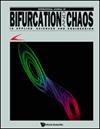带伪中心的片断二次微分系统的全局相位肖像
IF 1.9
4区 数学
Q2 MATHEMATICS, INTERDISCIPLINARY APPLICATIONS
引用次数: 0
摘要
本文论述了由两条不同矢量场构成的平面片断平滑微分系统的全局动力学,这两条矢量场被一条穿过原点的直线隔开。从原点为伪焦点的片断二次微分系统准规范族(有六个参数)出发,我们研究了原点确实是伪中心的子族。对于这些子系,我们对其在波恩卡莱盘中的全局相位肖像和相关的分岔集进行了分类。本文章由计算机程序翻译,如有差异,请以英文原文为准。
Global Phase Portraits of Piecewise Quadratic Differential Systems with a Pseudo-Center
This paper deals with the global dynamics of planar piecewise smooth differential systems constituted by two different vector fields separated by one straight line that passes through the origin. From a quasi-canonical family of piecewise quadratic differential systems with a pseudo-focus point at the origin, which has six parameters, we investigate the subfamilies where the origin is indeed a pseudo-center. For such subfamilies, we classify its global phase portraits in the Poincaré disk and the associated bifurcation sets.
求助全文
通过发布文献求助,成功后即可免费获取论文全文。
去求助
来源期刊
CiteScore
4.10
自引率
13.60%
发文量
237
审稿时长
2-4 weeks
期刊介绍:
The International Journal of Bifurcation and Chaos is widely regarded as a leading journal in the exciting fields of chaos theory and nonlinear science. Represented by an international editorial board comprising top researchers from a wide variety of disciplines, it is setting high standards in scientific and production quality. The journal has been reputedly acclaimed by the scientific community around the world, and has featured many important papers by leading researchers from various areas of applied sciences and engineering.
The discipline of chaos theory has created a universal paradigm, a scientific parlance, and a mathematical tool for grappling with complex dynamical phenomena. In every field of applied sciences (astronomy, atmospheric sciences, biology, chemistry, economics, geophysics, life and medical sciences, physics, social sciences, ecology, etc.) and engineering (aerospace, chemical, electronic, civil, computer, information, mechanical, software, telecommunication, etc.), the local and global manifestations of chaos and bifurcation have burst forth in an unprecedented universality, linking scientists heretofore unfamiliar with one another''s fields, and offering an opportunity to reshape our grasp of reality.

 求助内容:
求助内容: 应助结果提醒方式:
应助结果提醒方式:


